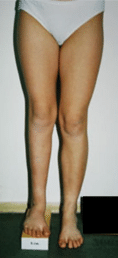
Leg length Discrepancy (LLD) occurs when there is a difference between the lengths of the legs. This may be due to a difference between either the upper and/or lower legs.
There are several causes of LLD. Some include:
The majority of the time, the cause of leg length discrep-ancy is unknown, especially in cases involving underde-velopment of the leg, or par-tial overgrowth of one side of the body. These condi-tions are usually present at birth, but the leg length dis-crepancy may be too small to be detected. As the child grows, the limb length dis-crepancy increases and be-comes more noticeable. In underdevelopment, the tibia or fibula is abnormally short. In cases of overgrowth (hemihypertrophy), Wilms’ Tumor of the adrenal gland must be ruled out.

Limb length discrepancy can be measured by a physician during a physical examination. The more accurate measurement of LLD is by using radiographs.
Usually, the physician measures the level of the hips when the child is standing barefoot. A series of measured wooden blocks may be placed under the short leg until the hips are level. X-rays may be ordered by your doctor to confirm the diagnosis or to exclude other problems.

In growing children, a physician may repeat the physical examination and x-rays every six months to a year to see if the leg length discrepancy has increased or remained unchanged. In some patients, monitoring may be done on a more frequent basis, as determined by your physician. Often, the bone age will be determined with an x-ray of the hand and wrist which is compared to a book of standards.
The effects of leg length discrepancy will vary from patient to patient, depending on the cause and amount of difference. Differences greater than one inch in a younger child may cause noticeable abnor-malities when walking. These differences may also require the patient to exert more effort to walk.

No, there is no guaranteed method of preventing a child from developing leg length discrepancy.
Each child is different, and your physician will suggest the best treatment option for the child. These include:
Continued observation of the leg length discrepancy to check for progression as the child or adolescent grows. Observation will include a physical exam and radiographs.
A lift fitted to the shoe can often improve walking and running, as well as relieve any back or knee pain that may be caused by the leg length discrepancy. Shoe lifts are inexpensive and can be removed from the shoe.
Correction can be made using plate epiphysiodesis, a minimally invasive surgical method for correcting leg length discrepancies. Bone growth is restricted on the operated leg while bone growth continues on the opposite side. Gradually the leg length equalizes, and the discrepancy is corrected. Since the bones are never cut with plate epiphysiodesis, there is less neurovascular risk, less instability, and a shorter duration of healing than with traditional epiphysiodesis.